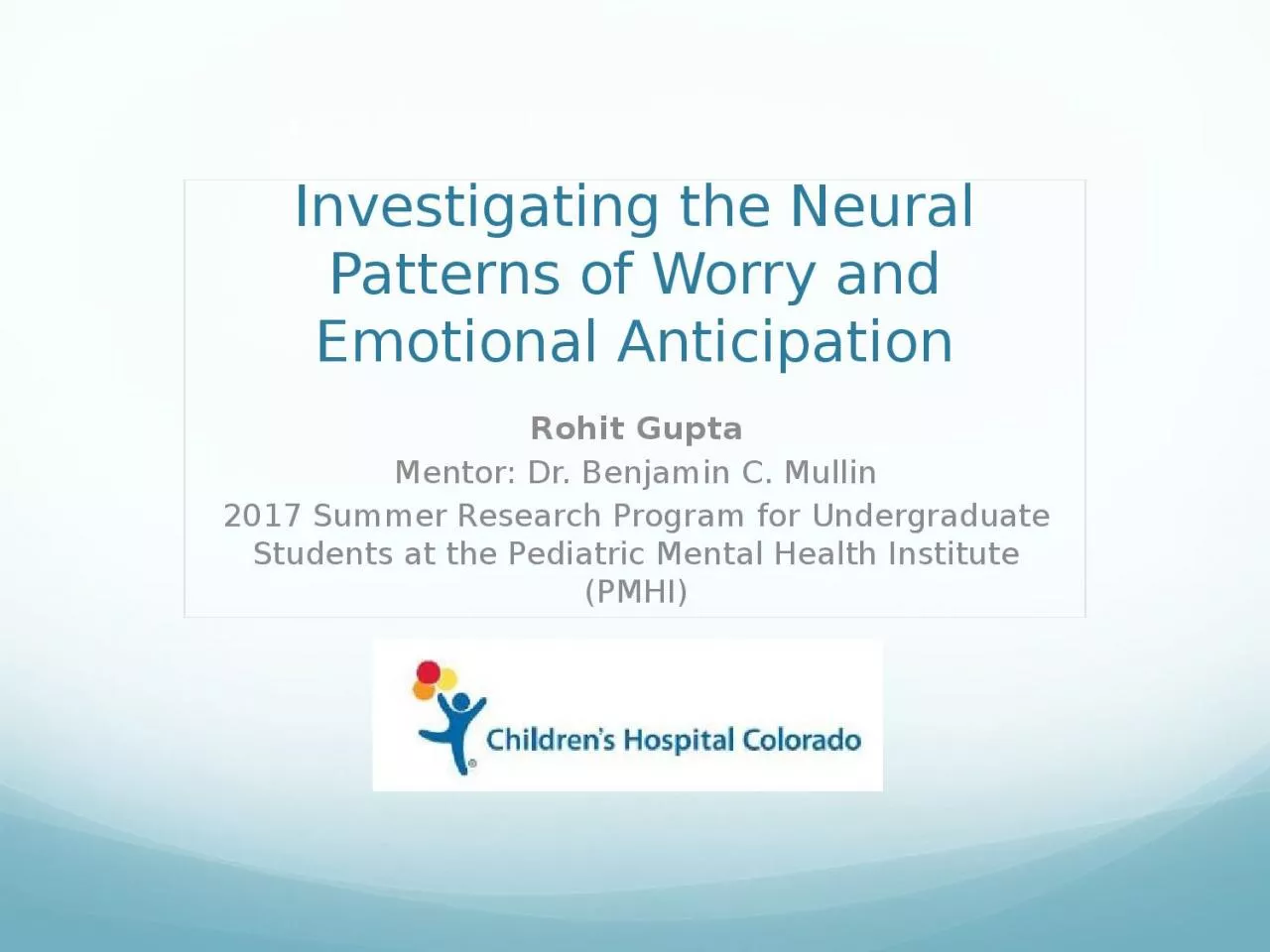

Rohit Gupta Mentor Dr Benjamin C Mullin 2017 Summer Research Program for Undergraduate Students at the Pediatric Mental Health Institute PMHI Background Worry is a process by which people anticipate ID: 1036834
Download Presentation The PPT/PDF document "Investigating the Neural Patterns of Wor..." is the property of its rightful owner. Permission is granted to download and print the materials on this web site for personal, non-commercial use only, and to display it on your personal computer provided you do not modify the materials and that you retain all copyright notices contained in the materials. By downloading content from our website, you accept the terms of this agreement.
1. Investigating the Neural Patterns of Worry and Emotional AnticipationRohit GuptaMentor: Dr. Benjamin C. Mullin2017 Summer Research Program for Undergraduate Students at the Pediatric Mental Health Institute (PMHI)
2. BackgroundWorry is a process by which people anticipate uncertain negative emotional eventsPrevious studies have found activation in the anterior cingulate cortex and anterior insular cortexStraube et al., NeuroImage. 2006Anterior cingulateLeft anterior insula
3. Problem StatementMajority of previous worry studies have been conducted in healthy adultsHowever, previous imaging studies used worry inductionsAdolescent brains are far different from healthy adultsWe aimed to characterize the emotional anticipation neural activation patterns in an adolescent and clinical population
4. Research HypothesesHypothesis 1: Anticipation of negative emotional stimuli will result in heightened activation of the anterior insular cortex and anterior cingulate cortexHypothesis 2: Adolescents with greater self-reported worry will have higher levels of activity in brain regions involved in emotional anticipation
5. Methodologyn = 23, ages 13-17, mean age = 15.5Participants first completed the Penn State Worry Questionnaire (PSWQ)Participants completed the emotional anticipation task while blood oxygen level dependent (BOLD) fMRI images were collected (measuring whole-brain activity)Data were processed using Statistical Parametric Mapping software (SPM12) and CONN toolbox in MATLAB version R2017a
6. Eliciting Uncertainty: The Emotional Anticipation Task
7. Ambiguous CueNeutral CuefMRI whole-brain activity data collection and processingIndividual activation dataIndividual activation dataExtraction of significant activity (p < 0.001, voxel threshold = 15)Ambiguous cue brain activation patternNeutral cue brain activation patternSUBTRACTSo how did we do it?
8. Results: Activation of the anterior insula and visual cortex are higher following ambiguous cues compared to neutral cuesAmbiguous cue – Neutral Cue contrastHypothesis: Activation in the anterior insulaHypothesis: Activation in the anterior cingulate!!
9. Pearson correlation reveals significant positive relationship between PSWQ score and right frontal cortex activation following ambiguous cueAverage worrySevere worryr = 0.415, p = 0.049
10. ConclusionsElevated activity in the right pre-frontal cortex (PFC), bilateral anterior insula, and primary visual cortex, but not the anterior cingulate characterizes emotional anticipationIncreased activation in the right PFC cluster is significantly positively correlated to severity of worry in adolescentsWidespread visual cortex activation may be due to mentally preparing for the visualization of negative imagesFindings are directly applicable to clinical populations
11. Future DirectionsWith these findings, we can formulate better treatment options and adjust therapies for adolescentsFuture studies will focus on examining whether successful treatment of worry normalizes the excessive activation of the right prefrontal cortex during anticipation of uncertain events
12. LimitationsSmall sample sizeOngoing studyUnable to determine if the viewing the anticipation cue altered the processing of the images
13. AcknowledgmentsBenjamin Mullin, PhDEmmaly Owens, MAMerlin Ariefdjohan, PhD, MPHMarisa DeguzmanProgram sponsors:Dr. Dominique Martinez (CCTSI)Dr. Douglas Novins and Dr. Jennifer Hagman (PMHI)